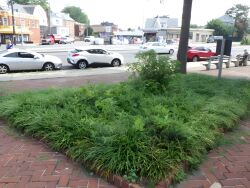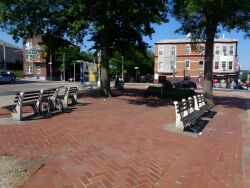Barclay Triangle
Barclay Triangle
Located at the intersection of Astoria Boulevard, 31st Avenue, and 102nd Street, this triangle pays tribute to the memory of Liev Barclay (1897-1917), a native of Queens who died in the First World War. At the age of nineteen, Barclay left the United States for France, hoping to see action in the First World War. He served first with the American Ambulance Corps, and then with the LaFayette Flying Corps. The LaFayette Flying Corps, an organization of American and French financiers and professionals, was created to assist young Americans such as Barclay in enlisting in the French Aviation Service. In 1916, Barclay joined the Escadrille Lafayette, or Lafayette Squadron. For his distinguished service, he received many citations, including the Medal of the Ligne Internationale des Aviateurs, or the International Legion of Aviators Medal, the LaFayette Flying Corps Medal, and the Croix de Guerre, one of the highest awards for valor in the French military. On June 1, 1917, Liev Barclay was killed over the skies of France.
Barclay Triangle lies within the neighborhood of East Elmhurst. East Elmhurst is one of several neighborhoods, including Elmhurst Square, Elmhurst South, Elmhurst Heights, and New Elmhurst, which began with the development of the larger neighborhood of Elmhurst in the 1890s. Founded by the Dutch in 1652, Elmhurst was originally known as Newtown. It encompassed the northwestern portion of Queens for over two centuries, until Long Island City was given a separate charter in 1870. In the 1890s, the Cord Meyer Development Company completely transformed the Newtown area, laying out streets, building several new residences, and creating new neighborhoods. In 1896, Cord Meyer, the owner of the company, named his development Elmhurst, meaning "a grove of elms." His intention was to disassociate the neighborhood from the foul smells of Newtown Creek, a tributary of the East River that runs inland for three miles, and serves as the boundary between the boroughs of Brooklyn and Queens. Between 1905 and 1930, the other developments - Elmhurst Square, Elmhurst South, Elmhurst Heights, New Elmhurst, and East Elmhurst - came into being. Today, these neighborhoods are among the most ethnically diverse and culturally rich in the city.
In November 1933, the City of New York acquired the land that is now Barclay Triangle. Six years later, Parks assumed jurisdiction over the property. On March 9, 1939, a local law designated the park, Liev Barclay Square "to pay a lasting tribute to the memory of a sterling young American who made the supreme sacrifice in the World War".
Barclay Triangle is a small parkland decorated with red brick walkways, benches, and five Pin Oak trees. Growing to heights of fifty to seventy-five feet, Pin Oak trees (Quercus palustris) are found in many of the city's parks, and in many urban areas throughout the Midwestern and Eastern United States. The tree's popularity is due mainly to its full, pyramidal shape, glossy leaves, and ability to withstand harsh urban conditions. Pin Oak trees are also attractive sources of autumn color, with their medium-green leaves becoming brilliantly red and bronze in the fall. With these beautiful trees and comfortable benches, Barclay Triangle is a soothing oasis in the midst of several major thoroughfares.
Check out your park's Vital Signs
Clean & Safe
Green & Resilient
Empowered & Engaged Users
Share your feedback or learn more about how this park is part of a
Vital Park System



